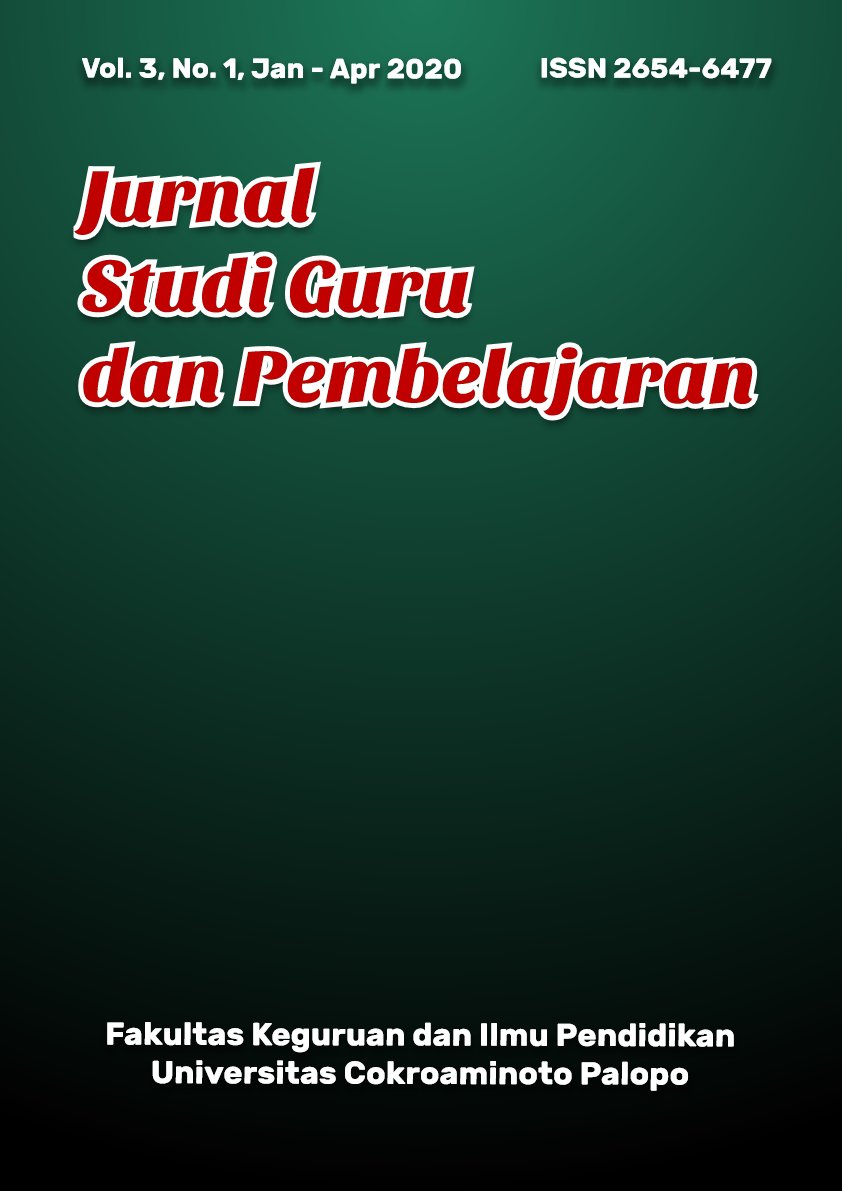Penggunaan Model Pembelajaran Visual Auditori Kinestetik (VAK) Berbasis Sosiodrama Dalam Meningkatkan Hasil Belajar IPS
Penelitian Tindakan Kelas di Kelas VIII-4 SMP Negeri 277 Jakarta
DOI:
https://doi.org/10.30605/jsgp.3.1.2020.240Keywords:
Classroom Action Research, Sociodrama Based Visual Auditory Kinesthetic Learning Model, Social Studies Learning Outcomes, Social Studies, Learning Outcomes, Sociodrama, Visual Auditory Kinesthetic, Learning ModelAbstract
This study aims to obtain empirical data regarding the use of Sociodrama-Based Visual Auditory Kinesthetic learning models in improving students' social learning outcomes. This research was conducted on students of class VIII-4 at SMP Negeri 277 Jakarta from October to November 2019. The research method used was Classroom Action Research (CAR). The study uses 3 cycles, and from each cycle consists of four stages, namely: Action Planning, Action Implementation, Observation, and Reflection. Based on the results of research from learning outcomes have increased in each cycle, cycle one of 52.77% (19 students) gained learning outcomes above KKM 79, cycle two by 75% (27 students) reached values above KKM 79, and cycle three of 88% (32 students) achieved a score above KKM 79. Besides that, the Sociodrama-Based Visual Auditory Kinesthetic Learning Model was able to increase the activeness of students in the aspects of asking, answering, arguing and working together. Thus it can be concluded that the use of Sociodrama-Based Visual Auditory Kinesthetic learning model can improve students' social studies learning outcomes and can increase student activity. So students can get better social studies learning outcomes that are above the KKM 79 standard.
Downloads
References
Ani, C. T. (2006). Psikologi Belajar. Semarang: UPT MKK UNNES.
Ahmadi, A. & Prasetya, J. T. (2005). Strategi Pembelajaran Untuk Fakultas Tarbiyah. Bandung: Pustaka Setia.
Arikunto, S. (2006). Prosedur Penelitian Suatu Tindakan Praktik. Jakarta: PT Rineka Cipta.
Daryanto, D. (2011). Penelitian Tindakan Kelas dan Penelitian Tindakan Sekolah beserta contoh-contohnya. Yogyakarta: Gaya Media.
DePorter, B & Hernacki, M. (2008). Quantum Learning: Membiasakan Diri Belajar Nyaman dan Menyenangkan. Bandung: Kaifa.
DePorter, B & Hernacki, M. (2008). Quantum Teaching. Bandung: Perpustakaan Nasional.
Djamarah, D. (2010). Strategi Belajar Mengajar. Jakarta: PT Rineka Cipta.
Hamdani, H. (2011). Strategi Belajar Mengajar. Bandung: Pustaka Setia.
Jensen, E. (2008). Brain-Based Learning. Yogyakarta: Pustaka Pelajar.
Malik, O. (2006). Metode Belajar dan Kesulitan-Kesulitan Belajar. Surabaya: Usaha Nasional.
Ngalimun, N. (2013). Strategi dan Model Pembelajaran. Yogyakarta: Aswaja Pressindo.
Pratiwi, E. (2017). Penggunaan Metode Diskusi Terbimbing untuk Meningkatkan Hasil Belajar Mata Pelajaran IPS (Penelitian Tindakan Kelas di kelas VII SMP Negeri 1 Cikarang). Jakarta: Universitas Negeri Jakarta DOI: https://doi.org/10.17509/ijposs.v1i1.2079
Purwanto, P. (2014). Evaluasi Hasil Belajar. Yogyakarta: Pustaka Pelajar.
Russel, L. (2011). The Accelerated Learning Fielbook. Bandung: Nusa Media.
Sanjaya, W. (2007). Strategi Pembelajaran Berorientasi Standar Proses Pendidikan. Jakarta: Kencana Prenada Media Group.
Sapriya, S. (2013). Pendidikan IPS. Bandung: Katalog Dalam Terbitan.
Sapriya, S. (2014). Pendidikan IPS. Bandung: PT. Remaja Rosdakarya.
Shoimin, A. (2016). Model Pembelajaran Inovatif Dalam Kurikulum 2013. Yogyakarta: Ar-ruzz Media.
Sudjana, N. (2011). Penilaian Hasil dan Proses Belajar Mengajar. Bandung: Rosda Karya Offset.
Sulhan, N. (2010). Pembangunan Karakter Pada Anak. Surabaya: Intelektual Club.
Supardi, S. (2015). Penelitian Tindakan Kelas. Jakarta: PT. Bumi Aksara.
Susanto, A. (2013). Teori Belajar dan Pembelajaran. Jakarta: Prenada Media Group.
Susanto, A. (2014). Pengembangan Pembelajaran IPS di Sekolah Dasar. Jakarta: Prenada Media Group.
Suwandi, S. (2008). Prosedur Penelitian Tindakan Kelas. Jakarta: Ghalia Indonesia.
Trianto, T. (2014). Model Pembelajaran Terpadu Konsep, Strategi, dan Implementasinya dalam Kurikulum Tingkat Satuan Pendidikan (KTSP). Jakarta: Bumi Aksara.
Usman, M. B. (2002). Metodologi Pembelajaran Agama Islam. Jakarta: Ciputat Pers.
Downloads
Published
How to Cite
Issue
Section
License
In submitting the manuscript to the journal, the authors certify that:
- They are authorized by their co-authors to enter into these arrangements.
- The work described has not been formally published before, except in the form of an abstract or as part of a published lecture, review, thesis, or overlay journal.
- That it is not under consideration for publication elsewhere,
- That its publication has been approved by all the author(s) and by the responsible authorities – tacitly or explicitly – of the institutes where the work has been carried out.
- They secure the right to reproduce any material that has already been published or copyrighted elsewhere.
- They agree to the following license and copyright agreement.
License and Copyright Agreement
Authors who publish with JSGP agree to the following terms:
- Authors retain copyright and grant the journal right of first publication with the work simultaneously licensed under Creative Commons Attribution License (CC BY-SA 4.0) that allows others to share the work with an acknowledgement of the work's authorship and initial publication in this journal.
- Authors are able to enter into separate, additional contractual arrangements for the non-exclusive distribution of the journal's published version of the work (e.g., post it to an institutional repository or publish it in a book), with an acknowledgement of its initial publication in this journal.
- Authors are permitted and encouraged to post their work online (e.g., in institutional repositories or on their website) prior to and during the submission process, as it can lead to productive exchanges, as well as earlier and greater citation of published work.






